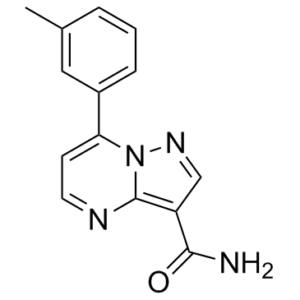CU-CPT-8m
This product is for research use only, not for human use. We do not sell to patients.

For small sizes, please check our retail website as below: www.invivochem.com
| Size | Price | Stock |
|---|---|---|
| 250mg | $1150 | Check With Us |
| 500mg | $1850 | Check With Us |
| 1g | $2775 | Check With Us |
Cat #: V3815 CAS #: 125079-83-6 Purity ≥ 98%
Description: CU-CPT-8m is a novel, potent and specific antagonist of Toll-like receptor 8 (TLR8) with immunomodulatory effects.
Top Publications Citing Invivochem Products
Publications Citing InvivoChem Products
Product Promise

- Physicochemical and Storage Information
- Protocol
- Related Biological Data
- Stock Solution Preparation
- Quality Control Documentation
| Molecular Weight (MW) | 252.28 |
|---|---|
| Molecular Formula | C14H12N4O |
| CAS No. | 125079-83-6 |
| Storage | -20℃ for 3 years in powder formr |
| -80℃ for 2 years in solvent | |
| Solubility In Vitro | DMSO: >30 mg/mLr |
| Water:<1 mg/mLr | |
| Ethanol: <1 mg/mL | |
| SMILES Code | CC1=CC=CC(=C1)C2=CC=NC3=C(C=NN23)C(=O)N |
| Synonyms | CU-CPT-8m; CU-CPT 8m; CU-CPT8m; CU CPT 8m |
| Protocol | In Vitro | CU-CPT-8m is a specific TLR8 antagonist, with an IC50 of 67±10 nM and negligible cytotoxicity. The Kd value of CU-CPT-8m is determined to be 220 nM. CU-CPT-8m only reduces the proinflammatory response in the TLR8-overexpressing cells strongly supports that CU-CPT-8m directly recognizes TLR8 in cells. It is particularly notable that TLR7 signaling is not affected at concentrations up to 75 μM. TLR7 and TLR8 are closely related and share many common ligands. Treatment of 1 μM CU-CPT-8m completely abolishes the elevation of TNF-α and IL-8 mRNA levels induced by R848. CU-CPT-8m inhibits R848-induced TNF-α production in the differentiated THP-1 monocytes cells in a dose-dependent manner with an IC50 of 90±10 nM, which is in good agreement with its IC50 value determined in HEK-Blue TLR8 cells. |
|---|
These protocols are for reference only. InvivoChem does not
independently validate these methods.
| Solvent volume to be added | Mass (the weight of a compound) | |||
|---|---|---|---|---|
| Mother liquor concentration | 1mg | 5mg | 10mg | 20mg |
| 1mM | 3.9638 mL | 19.8192 mL | 39.6385 mL | 79.2770 mL |
| 5mM | 0.7928 mL | 3.9638 mL | 7.9277 mL | 15.8554 mL |
| 10mM | 0.3964 mL | 1.9819 mL | 3.9638 mL | 7.9277 mL |
| 20mM | 0.1982 mL | 0.9910 mL | 1.9819 mL | 3.9638 mL |
The molarity calculator equation
Mass(g) = Concentration(mol/L) × Volume(L) × Molecular Weight(g/mol)
Mass
=
Concentration
×
Volume
×
Molecular Weight*
The dilution calculator equation
Concentration(start)
×
Volume(start)
=
Concentration(final)
×
Volume(final)
This equation is commonly abbreviated as: C1 V1 = C2 V2
Concentration(start)
C1
×
Volume(start)
V1
=
Concentration(final)
C2
×
Volume(final)
V2
Step One: Enter information below
Dosage mg/kg
Average weight of animals g
Dosing volume per animal µL
Number of animals
Step Two: Enter the in vivo formulation
%DMSO
+
%
+
%Tween 80
+
%ddH2O
Calculation Results:
Working concentration:
mg/ml;
Method for preparing DMSO master liquid:
mg
drug pre-dissolved in
µL
DMSO(Master liquid concentration
mg/mL)
,Please contact us first if the concentration exceeds the DMSO solubility of the batch of drug.
Method for preparing in vivo formulation:
Take
µL
DMSO master liquid, next add
µL
PEG300, mix and clarify, next add
µL
Tween 80,mix and clarify, next add
µL
ddH2O,mix and clarify.
Note:
- (1) Please be sure that the solution is clear before the addition of next solvent. Dissolution methods like vortex, ultrasound or warming and heat may be used to aid dissolving.
- (2) Be sure to add the solvent(s) in order.




































